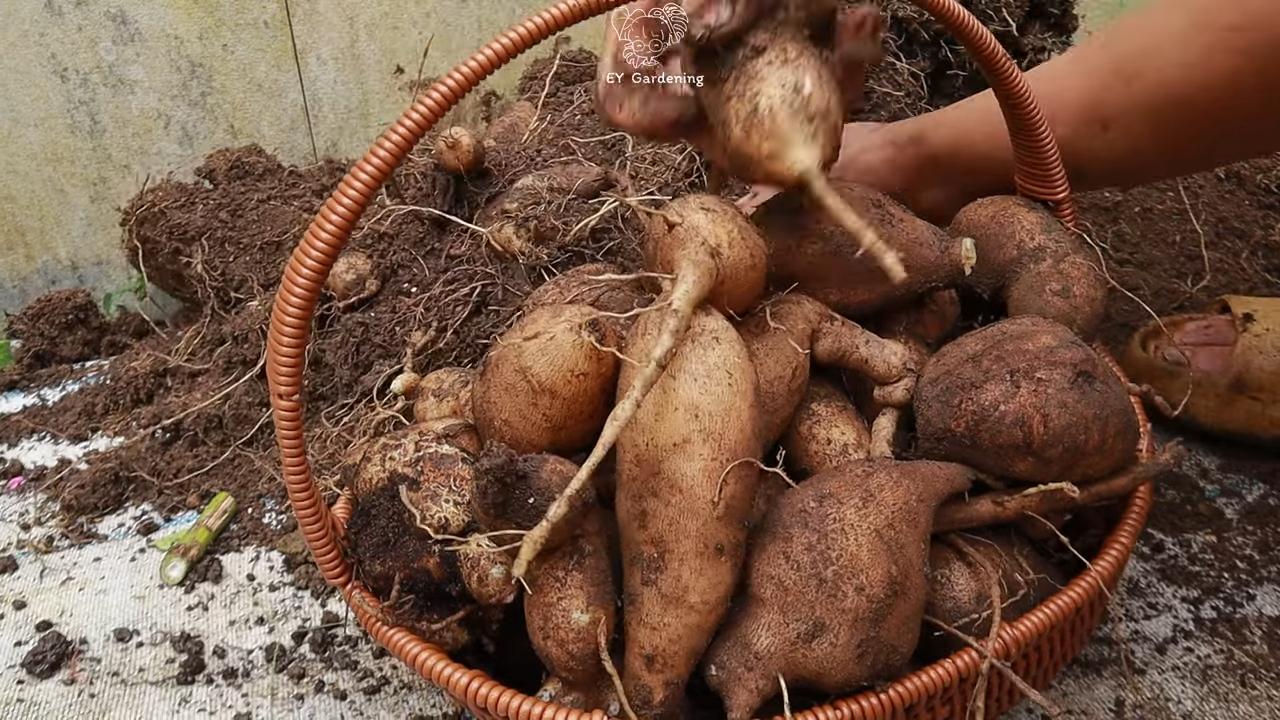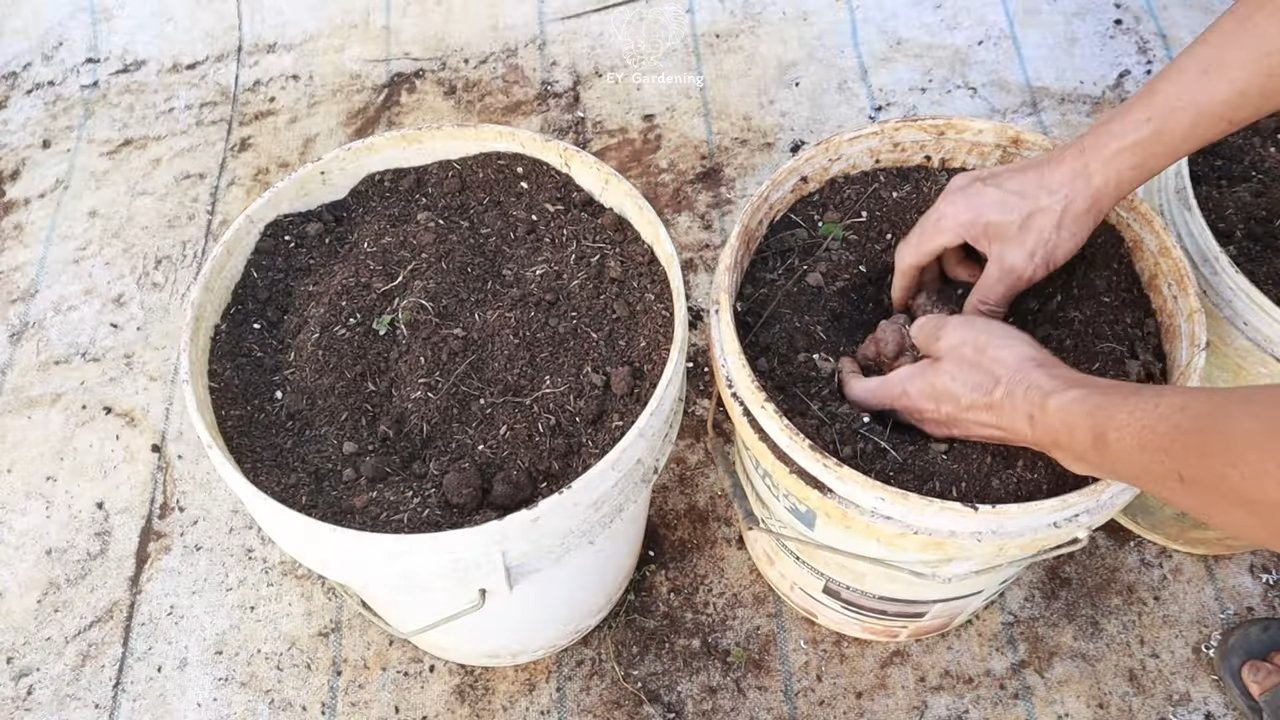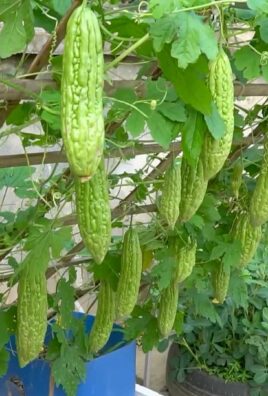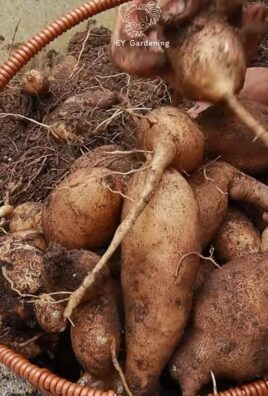Growing Yacon at Home might sound like an exotic gardening adventure, and trust me, it is! But don’t let the unfamiliar name intimidate you. I’m here to show you how surprisingly easy and rewarding it can be to cultivate this fascinating root vegetable right in your own backyard.
Yacon, sometimes called the “apple of the earth,” has a rich history rooted in the Andes Mountains of South America, where it has been cultivated for centuries. Indigenous communities have long valued it for its sweet, juicy tubers, which are not only delicious but also packed with prebiotics, making them a gut-friendly treat. Think of it as a naturally sweet potato with a refreshing, crisp texture – perfect for snacking, salads, or even juicing!
Why should you consider growing yacon at home? Well, for starters, you’ll have access to a unique and healthy food source that you won’t easily find in your local grocery store. Plus, it’s a fantastic conversation starter! But more importantly, in a world increasingly focused on sustainable living and knowing where our food comes from, cultivating your own yacon allows you to connect with nature and enjoy the satisfaction of harvesting something truly special. I’ll guide you through every step, from choosing the right variety to harvesting your bountiful crop, ensuring you have all the knowledge you need for a successful yacon-growing experience. Let’s get our hands dirty!

Growing Yacon at Home: A Beginner’s Guide to This Sweet Root Vegetable
Yacon, also known as the Peruvian ground apple, is a fantastic root vegetable that’s gaining popularity for its sweet, slightly apple-like flavor and its prebiotic benefits. I’ve been growing yacon in my garden for a few years now, and I’m always amazed at how easy and rewarding it is. If you’re looking for a unique and healthy addition to your garden, yacon is definitely worth a try! This guide will walk you through everything you need to know to successfully grow yacon at home.
Understanding Yacon: The Basics
Before we dive into the how-to, let’s get a little background on yacon. It’s a perennial plant, but in colder climates, it’s often grown as an annual because the tubers are sensitive to frost. The edible parts are the large, brown, knobby tubers that grow underground. These tubers are crisp and juicy, and they can be eaten raw, baked, roasted, or even juiced. The plant also produces smaller, reddish rhizomes (also called crowns) near the surface of the soil. These rhizomes are what you’ll use to propagate new plants.
What You’ll Need
* Yacon rhizomes (crowns): You can purchase these from nurseries or online suppliers. Make sure they look healthy and have visible buds.
* Well-draining soil: Yacon prefers loose, fertile soil.
* Compost or well-rotted manure: To enrich the soil and provide nutrients.
* A sunny location: Yacon needs at least 6-8 hours of sunlight per day.
* Watering can or hose: For regular watering.
* Shovel or garden fork: For planting and harvesting.
* Optional: Stakes or trellises: To support the tall plants.
* Optional: Mulch: To retain moisture and suppress weeds.
Getting Started: Pre-Sprouting Your Rhizomes (Optional but Recommended)
Pre-sprouting your rhizomes gives them a head start and can significantly improve your success rate, especially in areas with shorter growing seasons. Here’s how I do it:
1. Prepare a container: Choose a container with drainage holes, such as a seedling tray or a small pot.
2. Fill with potting mix: Use a well-draining potting mix.
3. Plant the rhizomes: Place the rhizomes horizontally on top of the potting mix, with the buds facing upwards. Gently cover them with about an inch of potting mix.
4. Water gently: Water the potting mix thoroughly, but avoid overwatering.
5. Provide warmth and light: Place the container in a warm, sunny location or under grow lights.
6. Keep the soil moist: Check the soil regularly and water when the top inch feels dry.
7. Wait for sprouts: In a few weeks, you should see sprouts emerging from the rhizomes.
Planting Your Yacon
Once your rhizomes have sprouted (or if you’re planting directly), it’s time to get them in the ground.
1. Choose a sunny location: Yacon thrives in full sun. Make sure the location you choose gets at least 6-8 hours of sunlight per day.
2. Prepare the soil: Yacon prefers well-draining soil that’s rich in organic matter. Amend the soil with compost or well-rotted manure before planting. This will improve drainage and provide essential nutrients.
3. Dig a hole: Dig a hole that’s about 6-8 inches deep and wide enough to accommodate the rhizome.
4. Plant the rhizome: Place the rhizome in the hole, with the sprouts facing upwards. If you’re planting directly without pre-sprouting, position the rhizome horizontally with the buds facing upwards.
5. Cover with soil: Gently cover the rhizome with soil and pat it down lightly.
6. Water thoroughly: Water the newly planted rhizome thoroughly.
7. Space your plants: If you’re planting multiple yacon plants, space them about 3-4 feet apart. This will give them enough room to grow and prevent overcrowding.
Caring for Your Yacon Plants
Yacon is relatively easy to care for, but here are a few tips to ensure a healthy and productive harvest:
1. Water regularly: Yacon needs consistent moisture, especially during dry periods. Water deeply whenever the top inch of soil feels dry. Avoid overwatering, as this can lead to root rot.
2. Fertilize occasionally: Yacon benefits from occasional fertilization. You can use a balanced organic fertilizer or side-dress with compost or well-rotted manure.
3. Weed regularly: Keep the area around your yacon plants free of weeds. Weeds compete for nutrients and water, which can stunt the growth of your yacon.
4. Provide support (optional): Yacon plants can grow quite tall (up to 6-7 feet), and they may need support to prevent them from falling over. You can use stakes or trellises to provide support.
5. Mulch (optional): Applying a layer of mulch around your yacon plants can help retain moisture, suppress weeds, and regulate soil temperature.
Dealing with Pests and Diseases
Yacon is generally resistant to pests and diseases, but here are a few things to watch out for:
* Slugs and snails: These pests can damage young yacon plants. Use slug and snail bait or handpick them off the plants.
* Aphids: Aphids can suck the sap from yacon leaves. Spray them with insecticidal soap or neem oil.
* Root rot: Root rot can occur in poorly drained soil. Make sure your soil is well-draining and avoid overwatering.
Harvesting Your Yacon
The best part of growing yacon is, of course, the harvest! Here’s how to harvest your yacon tubers:
1. Wait for the frost: Yacon tubers are typically harvested in the fall, after the first frost. The frost will kill the above-ground foliage, signaling that the tubers are ready to be harvested.
2. Cut back the foliage: Cut back the dead foliage to about 6 inches above the ground.
3. Dig carefully: Use a shovel or garden fork to carefully dig around the base of the plant. Be careful not to damage the tubers.
4. Lift the plant: Gently lift the plant from the ground, being careful not to break the tubers.
5. Separate the tubers: Separate the tubers from the rhizomes (crowns). The tubers are the large, brown, knobby roots. The rhizomes are the smaller, reddish roots near the surface of the soil.
6. Cure the tubers: Cure the tubers for a week or two in a cool, dry place. This will allow the sugars to develop and improve the flavor.
7. Store the tubers: Store the cured tubers in a cool, dark, and humid place, such as a root cellar or a refrigerator. They can be stored for several months.
8. Save the rhizomes: Save the rhizomes (crowns) for planting next year. Store them in a cool, dark, and slightly moist place, such as a container filled with peat moss or sawdust.
Enjoying Your Yacon
Now that you’ve harvested your yacon, it’s time to enjoy it! Yacon tubers can be eaten raw, baked, roasted, or juiced. They have a sweet, slightly apple-like flavor and a crisp, juicy texture.
* Raw: Peel and slice the tubers and eat them as a snack or add them to salads.
* Baked or roasted: Bake or roast the tubers like potatoes or sweet potatoes.
* Juiced: Juice the tubers for a refreshing and healthy drink.
* Syrup: Yacon syrup is a natural sweetener made from the juice of the tubers.
Propagating Yacon
Yacon is easily propagated from the rhizomes (crowns). Here’s how to propagate yacon:
1. Save the rhizomes: After harvesting the tubers, save the rhizomes (crowns).
2. Store the rhizomes: Store the rhizomes in a cool, dark, and slightly moist place, such as a container filled with peat moss or sawdust.
3. Plant the rhizomes: In the spring, plant the rhizomes in the garden, following the planting instructions above.
Troubleshooting
* My yacon plants are not growing well: Make sure your plants are getting enough sunlight, water, and nutrients. Check the soil drainage and amend with compost if necessary.
* My yacon tubers are small: This could be due to a number of factors, including poor soil, insufficient sunlight, or lack of water. Make sure your plants are getting the right conditions.
* My yacon tubers are

Conclusion
So, there you have it! Growing yacon at home is not only achievable, but it’s also a deeply rewarding experience. From the initial sprouting to the final harvest of those crisp, sweet tubers, every step of the process connects you to the earth and provides a tangible sense of accomplishment. Forget relying solely on specialty stores or farmers’ markets – with a little patience and the right approach, you can enjoy fresh, homegrown yacon whenever you desire.
The benefits extend far beyond just having access to this unique and delicious root vegetable. You’re also contributing to a more sustainable lifestyle by reducing your carbon footprint and supporting local food production (even if that “local” is your own backyard!). Plus, the yacon plant itself is a beautiful addition to any garden, with its lush foliage and vibrant flowers.
But the real magic lies in the taste and versatility of the yacon tuber. Whether you enjoy it raw in salads, roasted as a side dish, or juiced for a refreshing beverage, its subtly sweet and slightly crunchy texture is a delightful treat. And let’s not forget the health benefits! Yacon is packed with prebiotics, which are essential for gut health and overall well-being.
Don’t be afraid to experiment with different varieties of yacon to find your favorite flavor profile. Some varieties are sweeter than others, while some have a more pronounced earthy taste. You can also try different growing methods, such as container gardening or raised beds, to adapt to your specific space and climate. Consider companion planting with other vegetables and herbs that complement yacon’s growth, such as beans or marigolds.
Ready to embark on your own yacon-growing adventure? We encourage you to give it a try! Start small, learn as you go, and don’t be discouraged by any initial setbacks. Gardening is a journey, and every mistake is an opportunity to learn and improve.
And most importantly, we want to hear about your experiences! Share your tips, tricks, and triumphs in the comments below. Let’s create a community of yacon enthusiasts who can support and inspire each other. Together, we can unlock the full potential of this amazing plant and enjoy the many benefits of growing yacon at home. So grab your gardening gloves, prepare your soil, and get ready to experience the joy of homegrown yacon!
Frequently Asked Questions (FAQ)
What is yacon, and why should I grow it?
Yacon (Smallanthus sonchifolius) is a perennial plant native to the Andes region of South America. It’s cultivated for its crisp, sweet, and juicy tubers, which are often eaten raw or used in cooking. Growing yacon at home offers several advantages:
* **Freshness and Flavor:** Homegrown yacon is often fresher and more flavorful than store-bought varieties. You can harvest it at its peak ripeness and enjoy its unique taste.
* **Health Benefits:** Yacon is a good source of prebiotics, which promote gut health. It’s also low in calories and has a low glycemic index, making it a healthy choice for people with diabetes.
* **Sustainability:** Growing your own yacon reduces your reliance on commercially produced food, which can have a significant environmental impact.
* **Gardening Enjoyment:** Gardening is a rewarding hobby that can reduce stress and improve your overall well-being. Growing yacon is a fun and educational experience.
Is yacon difficult to grow?
Yacon is relatively easy to grow, especially in regions with mild climates. It prefers well-drained soil, plenty of sunlight, and regular watering. However, it’s important to protect the plants from frost, as they are not very cold-hardy. With a little care and attention, you can successfully grow yacon in your home garden.
What are the best growing conditions for yacon?
Yacon thrives in the following conditions:
* **Soil:** Well-drained, fertile soil with a pH of 6.0 to 7.0. Amend heavy clay soils with compost or other organic matter to improve drainage.
* **Sunlight:** At least 6 hours of direct sunlight per day.
* **Watering:** Regular watering, especially during dry periods. Keep the soil consistently moist but not waterlogged.
* **Temperature:** Yacon prefers warm temperatures (65-80°F). Protect plants from frost.
* **Fertilizer:** Apply a balanced fertilizer in the spring and again in mid-summer.
When is the best time to plant yacon?
The best time to plant yacon is in the spring, after the last frost. You can start the plants indoors a few weeks before the last frost to get a head start. Alternatively, you can purchase yacon crowns or rhizomes from a nursery or online supplier.
How do I harvest yacon?
Yacon is typically harvested in the fall, after the foliage has died back. Carefully dig up the tubers, being careful not to damage them. The tubers can be stored in a cool, dark place for several months.
How do I store yacon tubers after harvesting?
After harvesting, gently clean the yacon tubers and allow them to cure for a week or two in a cool, dry, and well-ventilated place. This curing process helps to sweeten the tubers and improve their storage life. Store the cured tubers in a cool, dark place, such as a root cellar or refrigerator. They should last for several months if stored properly.
Can I grow yacon in containers?
Yes, you can grow yacon in containers, especially if you live in an area with limited garden space. Choose a large container (at least 20 gallons) with good drainage. Use a high-quality potting mix and provide regular watering and fertilization. Container-grown yacon may not produce as many tubers as plants grown in the ground, but you can still enjoy a decent harvest.
Are there any pests or diseases that affect yacon?
Yacon is generally resistant to pests and diseases. However, it can be susceptible to slugs and snails, especially when the plants are young. You can protect your plants by using slug and snail bait or by hand-picking them off the plants. In some cases, yacon may also be affected by fungal diseases, such as powdery mildew. To prevent fungal diseases, ensure good air circulation around the plants and avoid overwatering.
What are some ways to use yacon in cooking?
Yacon tubers can be eaten raw, roasted, grilled, or juiced. They have a sweet, slightly crunchy texture and a flavor that is often compared to apples or pears. Here are some ideas for using yacon in cooking:
* **Raw:** Slice yacon thinly and add it to salads, slaws, or fruit platters.
* **Roasted:** Roast yacon with other root vegetables, such as carrots, potatoes, and sweet potatoes.
* **Grilled:** Grill yacon slices and serve them as a side dish or appetizer.
* **Juiced:** Juice yacon and drink it as a refreshing beverage.
* **Baked Goods:** Grate yacon and add it to muffins, cakes, or breads.
* **Syrup:** Yacon syrup can be made by extracting the juice and simmering it until it thickens. It can be used as a natural sweetener.
Can I eat the yacon leaves?
While the tubers are the primary edible part of the yacon plant, the leaves are also edible, though less commonly consumed. They can be used in salads or cooked like spinach. However, it’s important to note that the leaves can be slightly bitter, so it’s best to use them sparingly.
What are the health benefits of yacon?
Yacon is a good source of prebiotics, which are non-digestible fibers that promote the growth of beneficial bacteria in the gut. These beneficial bacteria play a crucial role in digestion, immunity, and overall health. Yacon is also low in calories and has a low glycemic index, making it a healthy choice for people with diabetes. Some studies have suggested that yacon may also have antioxidant and anti-inflammatory properties.




Leave a Comment